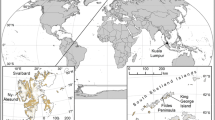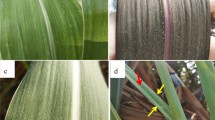Summary
The linear growth rates of fungal isolates were measured on agar plates at temperatures ranging from 4° to 35°C. Fungi tested included the major fungal colonizers of leaves and litter of the three dominant plant species on subantarctic Macquarie Island, and major fungal species associated with plant and soil communities near Australia's Casey Station on the Antarctic Continent. All fungi grew at 4°C and were classified as psychrotrophs. Maximum growth rates were recorded at temperatures of 10° to 20°C for 13 of the 15 isolates from Macquarie Island and for all six isolates from Casey. Most of the leaf colonizing fungi from Macquarie Island had optimum growth temperatures of 15°C whereas all litter fungi from Macquarie Island and Casey fungi except Thelebolus microsporus had optimum growth temperatures of 20°C or above. Maximum growth of all species was at temperatures above those normally prevailing in their natural environments, with most species growing at 4°C at between 10% and 30% of their maximum rates. However, microclimatic effects may have resulted at times in temperatures near their growth optima. The highest growth rates at 4°C were recorded for Phoma spp. 1 and 2, Phoma exigua and Mortierella gamsii from Macquarie Island and Mortierella sp. 1 from Casey. Thelebolus microsporus and sterile sp. G from Casey also grew relatively fast at 4°C, and these species, and Phoma sp. 3 and Phoma exigua from Macquarie Island had the lowest Q-10 values for the temperature range 4° to 15°C.
Similar content being viewed by others
References
Baker JH (1970) Quantitative study of yeasts and bacteria in a Signy Island peat. Br Antarct Surv Bull 23: 51–55
Baross JA, Morita RY (1978) Microbial life at low temperatures: ecological aspects. In: Kushner DJ (ed) Microbial life in extreme environments. Academic Press, London New York, pp 9–71
Bazin MJ, Prosser JI (1988) Physiological models in microbiology, vol 1. CRC Press, Florida
Bunt JS, Rovira AD (1955) Microbiological studies of some subantarctic soils. J Soil Sci 6:119–128
Domsch KH, Gams W, Anderson TH (1980) Compendium of soil fungi. Academic Press, London New York
Flanagan PW (1978) Microbial ecology and decomposition in arctic tundra and subarctic taiga ecosystems. In: Loutit MK, Miles JAR (eds) Microbial ecology. Proc Life Sci Intern Micro-Ecol Symp, New Zealand, Springer, Berlin Heidelberg New York, pp 161–168
Fletcher LD, Kerry EJ, Weste GM (1985) Microfungi of Mac.Robertson and Enderby Lands, Antarctica. Polar Biol 4: 81–88
Hurst JL, Pugh GJF, Walton DWH (1983) Fungal succession and substrate utilization on leaves of three South Georgia phanerogams. Br Antarct Surv Bull 56: 89–100
Ivarson KC (1965) The microbiology of some permafrost soils in the Mackenkie Valley, NWT. Arctic 18: 256–260
Jenkin JF (1975) Macquarie Island, subantarctic. In: Rosswall TA, Heal OW (eds) Structure and function of tundra ecosystems. Ecol Bull (Stockholm), pp 375–397
Kappen L (1988) Ecophysiological relationships in different climatic regions. In Galun M (ed) CRC Hand of lichenology, vol 2. CRC Press, Florida, pp 37–100
Kerry EJ, Weste GM (1985) Succession in the microflora of leaves and litter of three plant species at sub-antarctic Macquarie Island. In: Siegfried WR, Condy PR, Laws RM (eds) Antarctic nutrient cycles and food webs. Springer, Berlin Heidelberg, pp 597–605
Latter PM, Heal OW (1971) A preliminary study of the growth of fungi and bacteria from temperate and Antarctic soils in relation to temperature. Soil Biol Biochem 3: 365–379
Lewis Smith RI (1988) Recording bryophyte microclimate in remote and severe environments. In: Glime JM (ed) Methods in bryology. Proc Bryol Meth Workshop, Mainz, pp 275–284
Menna ME di (1960) Yeasts from Antarctica. J Gen Microbiol 23:295–300
Morita RY (1975) Psychrophilic bacteria. Bacteriol Rev 39: 144–167
Ratkowsky DA, Lowry DA, McMeekin TA, Stokes AN, Chandler RE (1983) Model for bacterial growth throughout the entire biokinetic range. J Bacteriol 154: 1222–1226
Sinclair NA, Stokes JL (1965) Obligately psychrophilic yeasts from the polar regions. Can J Microbiol 11: 259–269
Warcup JH (1950) The soil plate method for isolation of fungi from soil. Nature 166: 117–118
Wicklow DT, Malloch D (1971) Studies in the genus Thelebolus. 1. Temperature optima for growth and ascocarp development. Mycologia 63:118–131
Wynn-Williams DD (1982) Simulation of seasonal changes in microbial activity of Maritime Antarctic peat. Soil Biol Biochem 14: 1–12
Wynn-Williams DD (1986) Microbial colonization of Antarctic fellfield soils. Proc IV ISME: 191–200
Author information
Authors and Affiliations
Rights and permissions
About this article
Cite this article
Kerry, E. Effects of temperature on growth rates of fungi from subantarctic Macquarie Island and Casey, Antarctica. Polar Biol 10, 293–299 (1990). https://doi.org/10.1007/BF00238428
Received:
Accepted:
Issue Date:
DOI: https://doi.org/10.1007/BF00238428




